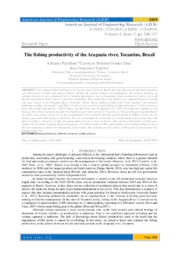The fishing productivity of the Araguaia river, Tocantins, Brazil.
The fishing productivity of the Araguaia river, Tocantins, Brazil.
Author(s): PRYSTHON, A.; DIAS, C. R. G.; VALÉRIO, J. F.
Summary: The Araguaia River belongs to the second largest basin in Brazil and take place in an important transition zone betweenthe Cerrado and Amazon biomes. Despite the relative richness of ichthyofauna, the greatest challenge of artisanal fisheries is the widespread lack of landing information. Lack of knowledge about productivity leads to the myth that the degradation of fish stocks is caused by overfishing. The productivity of the gillnets was compared between drougth and rainy season in the Araguaia River, Tocantins, Brazil. Eleven fishing ground points were sampled with artisanal fishermen, monthly, during 2017 and 2018. 273 throw were carried out with gillnets of different meshes (7 to 22 cm knot to knot). The results indicated low CPUE indices and that there was no difference (P> 0.05) in productivity (kg/throw) and time per throw (hour) between drought (2.42 kg/throw) and rainy season (2,71 kg/ throw). Forage fish species predominated in catches, and meshes of size 11 cm was predominant. It is concluded that the greatest threats to fishing activity are not directly associated with fishing productivity. We also recommend the promotion of a broad debate with society about the future of fishery resources, so that the management process is more inclusive, with greater participation of fishermen. Finally, the Tocantins Araguaia basin encompasses 7.2 million people in 409 municipalities and artisanal fishing is one of the most important activities for maintaining food security, the economy and the culture of thousands of communities that depend on the river.
Publication year: 2019
Types of publication: Journal article
Observation
Some of Embrapa's publications are published as ePub files. To read them, use or download one of the following free software options to your computer or mobile device. Android: Google Play Books; IOS: iBooks; Windows and Linux: Calibre.
Access other publications
Access the Agricultural Research Database (BDPA) to consult Embrapa's full library collection and records.
Visit Embrapa Bookstore to purchase books and other publications sold by Embrapa.

